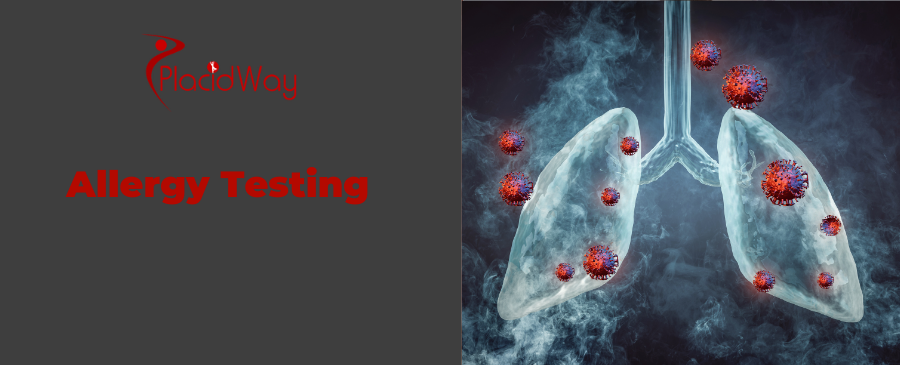
Uncover Your Allergy Triggers: Comprehensive Testing for Lasting Relief
Do you often find yourself battling a persistent runny nose, itchy eyes, skin rashes, or sudden breathing difficulties, especially after eating certain foods or encountering specific environments? If these frustrating symptoms sound familiar, you might be experiencing allergies – an immune system overreaction to otherwise harmless substances. Living with undiagnosed allergies can significantly impact your daily life, making simple activities a challenge and eroding your overall well-being.
Allergy testing is the definitive way to pinpoint what exactly is triggering your body's defensive response. It's not just about identifying the problem; it's the critical first step towards creating an effective management plan, whether that involves avoiding certain allergens, medication, or advanced treatments like immunotherapy. Imagine finally understanding why you feel unwell and having the tools to regain control of your health.
Many individuals search for "what causes my allergies," "how to stop chronic sneezing," or "best tests for food allergies." Allergy testing provides those crucial answers. For those seeking accessible and affordable high-quality care, exploring allergy testing options abroad has become a compelling choice. Medical tourism offers an opportunity to receive world-class diagnostic services, often at a fraction of the cost found in your home country, allowing you to breathe easier and live more freely.
What symptoms suggest I might need allergy testing?
Allergies can manifest in a variety of ways, often mimicking common colds or skin conditions, making self-diagnosis difficult. Here are key symptoms that should prompt you to consider allergy testing:
- Respiratory Symptoms: Persistent sneezing, runny or stuffy nose (rhinitis), itchy nose, watery and itchy eyes (conjunctivitis), coughing, wheezing, shortness of breath, and chest tightness (asthma). These often worsen seasonally or after exposure to dust, pollen, or pets.
- Skin Symptoms: Hives (urticaria), eczema (atopic dermatitis) with itchy, red, flaky skin, or contact dermatitis (red, itchy rash where skin touches an allergen like nickel or certain plants).
- Digestive Symptoms: Nausea, vomiting, diarrhea, stomach cramps, or bloating, especially after consuming specific foods. In children, poor growth can also be a sign of food allergies.
- Other Symptoms: Swelling of lips, face, tongue, or throat (angioedema), dizziness, lightheadedness, or in severe cases, a life-threatening reaction called anaphylaxis, which includes difficulty breathing, a sudden drop in blood pressure, and loss of consciousness.
If you experience any of these symptoms regularly, especially if they follow a pattern related to specific exposures, it's time to investigate with allergy testing. Don't let chronic discomfort limit your life.
What commonly causes allergic reactions and how do they develop?
At its core, an allergic reaction is a miscommunication within your immune system. Instead of ignoring innocuous substances, your body perceives them as dangerous invaders. When you encounter an allergen, your immune system produces a type of antibody called Immunoglobulin E (IgE). These IgE antibodies attach to mast cells, which are abundant in areas like the skin, lungs, and gastrointestinal tract.
Upon subsequent exposure to the same allergen, it binds to the IgE on the mast cells, triggering the release of chemicals like histamine. Histamine is responsible for many common allergy symptoms – it causes blood vessels to dilate, leading to redness and swelling, and stimulates nerve endings, causing itching. Think of it like a faulty alarm system that goes off even when there's no real danger.
Common allergens include:
- Pollen: From trees, grasses, and weeds (seasonal allergies).
- Dust mites: Tiny insects that thrive in household dust.
- Pet dander: Flakes of skin, saliva, and urine from animals.
- Mold: Spores found indoors and outdoors in damp environments.
- Foods: Peanuts, tree nuts, milk, eggs, soy, wheat, fish, and shellfish are common culprits.
- Insect stings: Bees, wasps, hornets, yellow jackets.
- Medications: Penicillin and other antibiotics, aspirin.
- Latex: Found in gloves, balloons, and some medical devices.
Genetics play a significant role; if your parents have allergies, you're more likely to develop them. Environmental factors, such as exposure to certain pollutants or early life microbial exposures, are also believed to influence allergy development.
What different types of allergy tests are available?
Understanding the various types of allergy tests can help you discuss options with your doctor and find the most suitable diagnostic approach:
- Skin Prick Test (Scratch Test):
- How it works: Small drops of suspected allergens are placed on the skin (usually the forearm or back). A sterile lancet then lightly pricks the top layer of the skin, allowing the allergen to enter.
- What it detects: Immediate allergic reactions to airborne allergens (pollen, dust mites, pet dander), certain foods, and insect venom.
- Results: Reactions typically appear within 15-20 minutes as a red, itchy bump (wheal) similar to a mosquito bite, indicating sensitivity.
- Pros: Quick results, relatively inexpensive, highly sensitive.
- Intradermal Test:
- How it works: A small amount of allergen is injected just under the skin.
- What it detects: Often used when skin prick tests are negative but an allergy is still suspected, particularly for venom or certain drug allergies.
- Pros: More sensitive than skin prick tests for some allergens.
- Cons: Slightly higher risk of systemic reaction, less commonly used than skin prick.
- Blood Test (Specific IgE Blood Test or RAST/ImmunoCAP):
- How it works: A blood sample is taken and sent to a lab to measure the amount of IgE antibodies to specific allergens.
- What it detects: A wide range of allergens, including foods, pollen, dust mites, and pet dander.
- Pros: Can be done regardless of skin condition, medication use (antihistamines don't interfere), or age. Safer for those at high risk of anaphylaxis.
- Cons: Results take longer (days to weeks), generally more expensive, and less sensitive than skin prick tests for some allergens.
- Patch Test:
- How it works: Allergens (e.g., metals, fragrances, preservatives) are applied to patches, which are then taped to the skin (usually the back) for 48 hours.
- What it detects: Delayed allergic reactions, typically contact dermatitis, which manifests as a rash after a few days.
- Pros: Effective for identifying causes of contact dermatitis.
- Cons: Requires multiple visits and takes several days for results.
- Oral Food Challenge:
- How it works: Under strict medical supervision, increasing amounts of a suspected food allergen are given to the patient to observe for a reaction.
- What it detects: The gold standard for diagnosing food allergies or determining if an allergy has been outgrown.
- Pros: Most accurate test for food allergies.
- Cons: Can trigger severe reactions; always done in a controlled clinical setting with emergency equipment.
Your allergist will determine the most appropriate test based on your symptoms, medical history, and suspected allergens.
Am I eligible for allergy testing, and who benefits most?
If you're asking "should I get tested for allergies?" the answer is often yes, especially if you experience:
- Persistent or Recurring Symptoms: Such as chronic nasal congestion, sneezing, itchy eyes, skin rashes, or unexplained digestive issues.
- Symptoms Worsening with Exposure: If your symptoms consistently appear after contact with certain foods, pets, dust, pollen, or specific environments.
- Unexplained Anaphylaxis: A history of severe, life-threatening allergic reactions where the trigger is unknown.
- Asthma or Eczema That's Difficult to Control: Allergies can often exacerbate these conditions, and identifying triggers can lead to better management.
- Family History of Allergies or Asthma: A genetic predisposition increases your likelihood of developing allergies.
Who might not be suitable or needs special consideration?
- Severe Skin Conditions: Extensive eczema or dermatitis can interfere with skin testing.
- Certain Medications: Antihistamines, some antidepressants, and beta-blockers can affect skin test results or increase the risk during testing. Your doctor will advise on stopping these temporarily.
- Pregnancy: While generally considered safe, some doctors prefer to avoid allergy testing during pregnancy unless absolutely necessary.
- Young Children: While safe for infants, blood tests might be preferred for very young children due to cooperation levels, although skin tests can be performed.
Always consult with an allergist or immunologist to determine your eligibility and the most appropriate testing method.
What should I expect during and after allergy testing, including recovery?
Knowing what to expect can alleviate any anxiety about the procedure:
During the Test:
- Preparation: You'll typically be asked to avoid antihistamines and certain other medications for a few days to a week before skin tests, as they can suppress reactions. No special preparation is needed for blood tests.
- Skin Prick Test: Your arm or back will be cleaned. The allergist will mark areas, apply drops of allergens, and then gently prick the skin surface with a sterile lancet. This feels like a slight scratch or prick, not usually painful. The process for multiple allergens takes about 15-20 minutes, followed by a waiting period for reactions to develop.
- Blood Test: A healthcare professional will draw a small sample of blood from your arm, similar to a routine blood test. This is quick and typically causes only a brief pinch.
- Patch Test: Patches containing allergens are applied to your back and remain there for 48 hours. You'll return to the clinic to have them removed and the skin examined, and often for a final reading 24-48 hours after removal.
After the Test and Recovery:
- Skin Prick Test: If you're allergic to a substance, a red, itchy bump (wheal) will appear, similar to a mosquito bite. These reactions are usually mild and localized. The allergist will measure these reactions to interpret the results. The itching and redness usually subside within a few hours. You can apply a mild corticosteroid cream or take an antihistamine (after the test is read) to relieve discomfort.
- Blood Test: There are no immediate side effects, other than possibly a small bruise at the blood draw site. You can resume all normal activities immediately. Results will be sent to your doctor from the lab.
- Patch Test: The areas where the patches were applied might be red or itchy, especially if you reacted to an allergen. This reaction can persist for several days.
In all cases, recovery is generally immediate and straightforward. Your doctor will discuss your results and formulate a personalized allergy management plan, which might include avoidance strategies, medications, or immunotherapy.
What are the potential risks and side effects of allergy testing?
While allergy testing is a routine procedure, it's important to be aware of potential, albeit rare, risks:
- Mild Local Reactions (Common):
- Skin Prick/Intradermal Tests: The most common side effects are localized itching, redness, and swelling at the test site, which usually resolves within a few hours. These are the intended reactions that help diagnose allergies.
- Patch Tests: Localized itching, redness, and possibly blistering where the patches were applied. These reactions are part of the diagnostic process for contact dermatitis.
- Systemic Reactions (Rare but Serious):
- In very rare cases, especially with intradermal tests or if a patient is highly sensitive, a severe allergic reaction (anaphylaxis) can occur. Symptoms include widespread hives, swelling, difficulty breathing, dizziness, or a drop in blood pressure. This is why allergy tests are always performed in a clinic where medical staff are trained to recognize and treat anaphylaxis immediately with emergency medications like epinephrine.
- False Positives/Negatives:
- False Positive: A test shows an allergy when one doesn't exist. This is more common with skin tests and sometimes due to cross-reactivity (e.g., reacting to birch pollen and also to apples).
- False Negative: A test shows no allergy when one actually exists. This can happen if the allergen concentration is too low, the patient is on antihistamines, or for very specific allergies.
- Discomfort:
- Skin prick tests can be itchy but are generally not painful. Blood tests involve a brief pinch. Patch tests can cause itching for several days.
Your allergist will carefully assess your medical history and discuss these risks before proceeding with any testing. The benefits of an accurate diagnosis for managing allergies typically far outweigh these minimal risks.
How do allergy testing costs compare across different countries?
The cost of allergy testing can be a significant barrier for many, especially if comprehensive panels are needed or if insurance coverage is limited. This is where medical tourism provides a compelling alternative. Prices are influenced by the type of test, the number of allergens tested, the clinic's reputation, and the country's general cost of living and healthcare infrastructure.
Estimated Worldwide Allergy Testing Costs (Indicative per panel/test, USD)
| Country | Typical Cost Range (USD) | Notes |
|---|---|---|
| United States | $300 - $1,500+ | Highly variable, depends on insurance, type, and number of allergens. Can be much higher for extensive panels. |
| Canada / United Kingdom | $200 - $800 | Often covered by public health for necessary tests; private options available. |
| Mexico | $150 - $500 | Popular for US patients seeking affordable care; good quality clinics in major cities. |
| Turkey | $100 - $400 | Emerging medical tourism hub with modern facilities, competitive pricing. |
| Thailand | $150 - $500 | Renowned for high-quality care, combines treatment with travel opportunities. |
| India | $100 - $350 | Very cost-effective, with many internationally accredited hospitals. |
| Poland / Czech Republic | $100 - $400 | Growing destinations in Eastern Europe, offering affordability and quality. |
These figures are estimates and can fluctuate based on the specific clinic, the comprehensiveness of the tests (e.g., number of allergens in a skin prick panel), and whether additional consultations or follow-up treatments are included.
Why should I consider traveling abroad for allergy testing?
The decision to seek medical care abroad, even for diagnostics like allergy testing, is increasingly popular. Here's why many patients choose this path:
- Significant Cost Savings: As seen in the cost comparison, the most compelling reason for many is the dramatic reduction in expenses, often 50% or more compared to Western countries. This makes comprehensive testing more accessible.
- Access to Advanced Technology and Specialists: Many leading medical tourism destinations have invested heavily in state-of-the-art diagnostic equipment and boast highly qualified, internationally trained allergists and immunologists.
- Reduced Waiting Times: In some countries, getting an appointment for allergy testing can involve long waits. Abroad, you can often schedule your tests quickly and receive prompt results, speeding up your path to diagnosis and treatment.
- Privacy and Anonymity: For some, seeking medical care away from their home country offers a greater sense of privacy.
- Quality of Care: Many international clinics and hospitals catering to medical tourists are accredited by international bodies like Joint Commission International (JCI), ensuring they meet rigorous global standards of patient safety and quality.
- Combine with Travel: The opportunity to explore a new culture, enjoy a vacation, or simply relax in a different environment before or after your procedure is a huge draw for medical tourists.
- Comprehensive Packages: Many overseas clinics and facilitators offer all-inclusive packages that cover testing, consultations, accommodation, and sometimes even travel arrangements, simplifying the process.
For those struggling with undiagnosed allergies and facing high costs or long waits at home, medical tourism for allergy testing presents a practical and often enriching solution.
What should I know about ensuring safety and quality when choosing an overseas clinic?
Choosing an overseas clinic requires careful consideration to ensure you receive safe and high-quality care. Here are essential steps:
- International Accreditation: Look for clinics accredited by reputable international organizations such as Joint Commission International (JCI). This signifies adherence to global benchmarks in patient safety and quality of care. Other accreditations like ISO also indicate quality management.
- Physician Qualifications and Experience: Verify that the allergists or immunologists are board-certified and have extensive experience in allergy diagnostics. Many international doctors receive training in Western countries. Ask about their professional memberships and specializations.
- Technology and Facilities: Ensure the clinic uses modern diagnostic equipment and adheres to hygiene and safety standards comparable to those in your home country.
- Patient Reviews and Testimonials: Seek out unbiased reviews from previous international patients. Websites, forums, and medical tourism platforms often feature patient experiences.
- Transparency in Pricing: Request a detailed, itemized quote for all services, including consultations, tests, and any potential follow-up. Be wary of clinics that are not upfront about costs.
- Communication: Confirm that the medical staff can communicate effectively in English or your preferred language. Clear communication is vital for understanding your condition and treatment plan.
- Medical Tourism Facilitator: Consider working with a reputable medical tourism company like PlacidWay. These facilitators specialize in vetting clinics, arranging travel logistics, and providing support throughout your journey, acting as an extra layer of assurance.
- Post-Procedure Care and Follow-up: Discuss how your results will be shared and if any follow-up care or prescriptions can be managed remotely or by your local doctor.
By taking these steps, you can confidently navigate your options and choose a safe and effective overseas allergy testing experience.
What are typical patient experiences and success stories with allergy testing abroad?
Patients who choose medical tourism for allergy testing often share similar success stories, characterized by relief, affordability, and a positive overall experience. Here are common themes:
- "Finally, Answers!" Many patients express immense relief at finally getting a definitive diagnosis after years of struggling with vague or persistent symptoms. "I spent so long wondering why I felt constantly tired and itchy," says Maria, who traveled to Thailand for testing. "The doctors there quickly identified my dust mite allergy, and for the first time, I have a clear plan."
- "Exceptional Care at a Fraction of the Cost." Cost is a recurring highlight. John from the UK, who went to Turkey for a comprehensive food allergy panel, noted, "I was quoted nearly £1,000 back home. In Istanbul, I got the same tests, saw a specialist, and even had a short vacation, all for less than half of that. The clinic was spotless, and the staff were incredibly kind."
- "Efficient and Timely Service." Patients often appreciate the lack of waiting lists and the speed with which appointments and results are managed. "I couldn't believe how quickly everything moved," shared Sarah, who visited Mexico. "From booking my consultation to getting my test results and a treatment plan, it was all done within a week, whereas I had a three-month wait at home."
- "A Positive Cultural Experience." Beyond the medical benefits, many enjoy the opportunity to travel. "It felt less like a medical trip and more like an adventure," remarks David, who combined his allergy testing in Poland with exploring Krakow. "The medical care was excellent, and I got to see a beautiful city too."
- "Empowerment Through Knowledge." The most profound impact is often the ability to manage their condition effectively. Knowing their specific triggers allows patients to make informed dietary choices, modify their environment, and pursue targeted treatments like immunotherapy, leading to a significant improvement in their quality of life.
These stories underscore the value that medical tourism brings to allergy diagnostics, offering a pathway to health and relief that is both high-quality and financially accessible.
Take the Next Step with PlacidWay
Ready to explore treatment options abroad? Discover top clinics, compare prices, and get a free quote tailored to your needs with PlacidWay.
Skin Care, Skin Rejuvenation





.png)

.jpg)
.jpg)

Share this listing